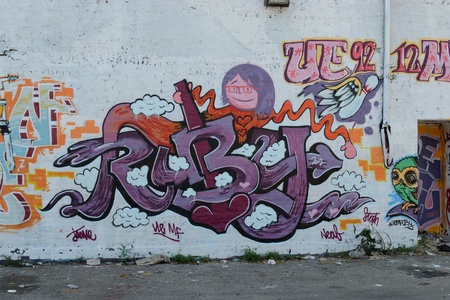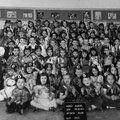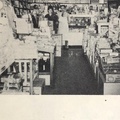The first time you hit a real wall, not a practice spot, you get this rush. Like, “I shouldn’t be doing this.” Especially when you’re running along the El tracks and there’s the third rail, a train might be coming, and you gotta jump onto a roof. It’s a thrill, and even more thrilling when you paint something and get to see it from the train the next day.
– Jamie Dihiansan, aka MENS

In 1990s Chicago, graffiti was an underground art form practiced in less than desirable conditions, by fringe dwellers under threat of legal ramifications. Oftentimes written off as simple vandalism, graffiti has also been referred to as the purest form of public art.
One prolific graffiti artist from this period was MENS from the UE crew, real name Jamie Dihiansan. A multi-ethnic Asian American of Japanese, Chinese, and Filipino descent, Jamie grew up in Chicago’s Peterson Park neighborhood. He is a veteran graphic designer that currently designs mobile apps for Basecamp, an award-winning project management software company rated by Forbes as one of America’s Best Small Companies in 2017.
Jamie parlayed his graffiti roots into a degree in Visual Communications from Loyola University Chicago. However, upon graduating high school, a career in the arts was the furthest thing from his mind.
“I went into college fully thinking pre-med. I never knew there were careers related to the arts, and neither did my parents. The track was always toward being a doctor, lawyer, accountant, something traditional along those lines. I never knew there was such a thing as graphic design as a career.”
His creative path began from finding himself something of a teenaged misfit, not quite fitting in anywhere.
“In high school, I tried fitting into different groups and really couldn’t find one. I ended up hanging out with a mixture of high school friends and friends from growing up, and we’d hit rave parties. Back then they were held illegally in warehouses across the city. You’d get these flyers circulating around and we’d meet up at these parties and start seeing the same people over and over again.
“The group I started meeting up with was into punk rock and new wave type music, skateboarding, and graffiti, pretty evenly integrated subcultures. And so because none of us really fit into any real existing groups, we sort of just created our own.
“It’s almost like work, where you get recruited with a crew or create your own, and because none of us really fit in with any other group - or maybe no other groups wanted us to be in their crew (laughs) - we went the route of creating our own. We figured we had our own sort of vibe and personality, so let’s just do it.”
They called themselves UE, an abbreviation for Under Estimated.
“Our crew was very diverse. I’m Asian, we had someone who was half Black half White, another half Black half Mexican, a guy who was Swedish and Italian, a Jewish guy, an Irish kid, we were kind of all over the place ethnically and racially but the unifying thing was music, skateboarding, and graffiti, and through our diversity formed our identity around that.
“Back in the nineties, before the internet, there was definitely a distinct Chicago style of graffiti. While that played a role in our style, we’d try taking a different perspective on things, try to be a little humorous in our stuff. So where someone might, say, paint a b-boy with gold chains, ski goggles, and a Kangol hat, I would paint a Hare Krishna character or something. Stuff that was a bit more surreal or alternative to the traditional graphics or characters.
“Back then in Chicago there were some walls that you could practice on when you wanted to try a piece. So there are tags, which are very simple, just quickly writing your name on something. Then you have throw-ups, which are normally two-color signatures, a fill-in color and outline color, also very quick and simple. And then there are pieces, which are multiple colors, generally more thought out. So if you wanted to do a piece and didn’t want to go up on a rooftop along the train line, there were key areas that you could practice.
“There was one place I would go near Wrigleyville - you know, back then that area was not that great - around School and Racine, where there was a permission wall. Actually, thinking back on it now I don’t even know if it was a permission wall, but it was just known you could go there and paint. It was like a warehouse and the rule was that if something was up for a little while you could just go over it. Or maybe that wasn’t the rule, but that’s what we did (laughs). Maybe people would get mad at us for that. There was another spot called the Cemetery Wall along the Red Line between Montrose and Irving, and then a building next to the Wilson train stop that was good to hit.
“Because I’m a North Sider I didn’t hit many spots on the South Side, but there was one wall in Chinatown I used to practice at, where New Chinatown is today, called the Walls of Fame. That was a really famous spot. People would meet up from all over the city there. It was a viaduct where the Metra train would go through. It was a great place to see paintings by people from all over the city. In fact, there was one time I was down there and the rapper Common - back then he was called Common Sense - he was scouting a location to shoot his first video. I don’t remember what the song was called, but if you see an old Common video in a tunnel with graffiti, that was the Walls of Fame on Cermak.” (Author’s note: The video was for the song “Take It EZ” by Common Sense from the 1992 album, “Can I Borrow a Dollar?)
Getting “up” as much as possible, or promoting one’s name with tags, throw-ups, and pieces, was the goal. And to be up as much as possible one had to be prolific, as the City of Chicago’s Graffiti Removal Services was equally prolific in removing the work ASAP.
“So what we would do is paint something and the next day we’d ride the train back and forth and just look at it, take pictures of it, really kind of examine our work to see what we did because you paint at night, under the cover of darkness, so it’s kind of hard to see.
“It’s an interesting thing when you’re an artist and you have thousands of people seeing your work. It’s a rush. That’s what really kept me going. And it wasn’t even the regular commuters that mattered to me, it was the other people in the scene that were seeing my stuff. That was my real audience.
“Even now I’ll still look around at who’s up, what names are up. And the person that painted it knows that I can see it, and that person is announcing, ‘This is me,’ by putting it up there for you to see. There’s just nothing like it.”
While permission walls were a part of the scene, to get one’s work in the most highly visible areas also meant sometimes not getting permission.
“That’s a part of writing that I’m not real proud of today, and thinking back on it we put ourselves in some real dangerous situations that I wouldn’t want my kids putting themselves into, like walking train tracks, climbing rooftops, getting arrested. I’m not making any excuses for it, we were young and just fumbling through it, doing stupid stuff, trying to get noticed.
“For me, getting arrested was the worst. I mean in the grand scheme of things it wasn’t murder or anything like that, but there was one time where my parents had to pick me up on a graffiti related charge and that was the worst feeling ever. When you consider immigrant parents are putting all their hopes and dreams into you, that definitely made me stop doing illegal stuff. I would still do permission walls and the Chicago Transit Authority started holding contests to alleviate illegal graffiti so I participated in those, but I decided I didn’t want to let my parents down by doing any more illegal writing.
“That said, one thing I want to say about my parents is that they’ve always been supportive even though they haven’t been verbally so. Once when I was in a CTA contest, I learned later that my parents went to check out the wall and they were watching me paint from afar. They didn’t come up to me or say that they were there, they just observed. I was, and still am, really appreciative of that.”
Although long retired from active graffiti writing, from time to time a MENS piece will pop up on a permission wall.
“I have friends that still do it casually, but in their regular lives they’re professionals in arts-related environments, whether they’re studio artists, graphic designers, or something like that. I still keep in touch with a handful of people in the scene and keep up with the culture. We still do a little bit, but are not super active.
“Of course, now that we’re older we talk to the owners of the businesses whose wall we want to paint. And stuff is a little more produced now anyway, by which I mean three or four people will go and paint something big that’s up for a while. Like if you go down by Milwaukee Avenue you’ll see a bunch of those things that have been up multiple years, and those people probably talked to those business owners to do that.
“Interestingly enough, it’s become this capitalist thing where now there’s paint made specifically for graffiti. Back then you’d use Krylon or Rust-Oleum cans that you’d find at a hardware store and pick whatever colors they made. Now companies come out with their own paint and you can get any shade of any color if you want to do really fine shading and some cans have different pressure, and you can get this stuff at graffiti stores. They’re not specifically called graffiti stores, but that’s essentially what they are. Not in the city, though, you have to go out to the suburbs.”
Much in the same way he found himself a social fringe dweller as a youth, Jamie finds himself in an odd position as a Japanese American. While he can often be found supporting local community events and his daughter is enrolled in an aikido class at the Japanese American Service Committee, he treads lightly with his Japanese identity.
“The Japanese side of me has been completely cut off, but I’ve really developed an interest in learning about it. My mother is half Japanese. Her name is Amasaco, a Filipinoized version of the Japanese name Masako. Her father’s name was Hajime Kukita and he passed away when she was a toddler. He came to the Philippines, we think from Kagoshima, as an architect and during the Japanese occupation was a noncombatant casualty of war when a building he was in was bombed. We took a family vacation to Japan in 2015 specifically to visit Kagoshima and get a sense of where we believe our family to be from.
“My mom grew up in a province called Pampanga, and my father, who is half Chinese, grew up in a city called Naga in the province of Bicol. So technically I’m a quarter Japanese, a quarter Chinese, and half Filipino, but I grew up culturally Filipino American.”
As a mixed race Nikkei myself, of Japanese and German descent, I can identify with Jamie’s diverse and distanced relationship with Japanese and Japanese American culture. As a result of Executive Order 9066, after evacuation, incarceration, and relocation, my family by and large distanced themselves from anything Japanese. I took it upon myself to integrate back into the community and introduce my children to the culture of their forebears. In this way, I can also identify with Jamie’s DIY spirit.
“I tell my kids,” he says, “there’s all sorts of jobs out there, and some might not even be invented yet. It kind of goes back to that DIY attitude and starting my own graffiti crew; you don’t have to wait for somebody to tell you, ‘Hey, do this.’ If you want something to exist, you do it.
“Be humble, let the work speak for itself, and always feel like you can do better. I don’t want to generalize, but I think the Asian American experience is to keep things on the down low, let the work speak for itself, keep at it without making a big deal of it, and keep refining the work to make it better. I don’t know if that’s a stereotype, but that’s the way I’ve always approached things.
“I want to impress upon my kids to not live someone else’s life. I see a lot of my peers living their parents’ dreams. Anything is possible, cliché as that may sound. It doesn’t matter what path you take as long as you’re doing your best.”
© 2018 Erik Matsunaga











